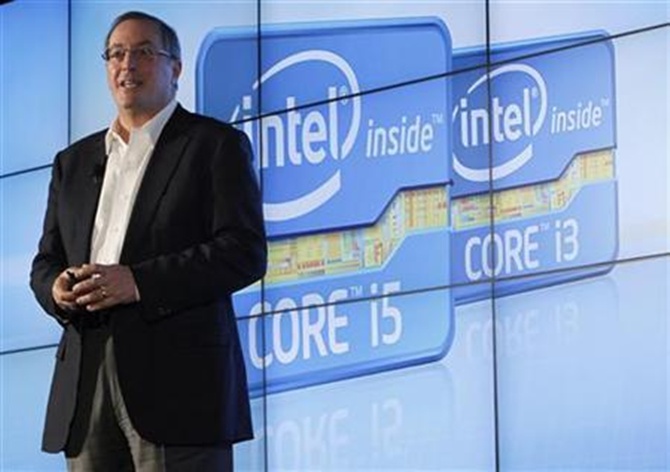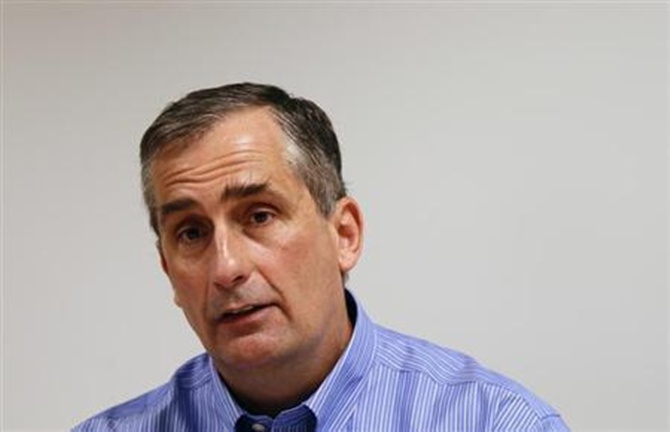Photographs: Steve Marcus/Reuters Noel Randewich, Ronald Grover and Liana B. Baker
The drastic change in plans for the retail spaces follows the company's abrupt abandonment of a grand plan to become an entertainment hub in living rooms around the world - a retreat that has been rumoured but not yet acknowledged by the company.
Earlier this year, Intel Corp rented temporary retail space in New York, Los Angeles and Chicago for a splashy launch of Intel TV, a new Internet entertainment service that the chipmaker promised could revolutionize the television industry.
But when customers walk into those stores this holiday season, they will not find any set-top TV boxes or programming services for sale.
Instead, they will see ultra thin laptops and new tablets from a variety of vendors that Intel hopes will help boost its massive but flagging computer chip business.
The drastic change in plans for the retail spaces follows the company's abrupt abandonment of a grand plan to become an entertainment hub in living rooms around the world - a retreat that has been rumored but not yet acknowledged by the company.
The project faced daunting challenges from the start, and Intel's new CEO, Brian Krzanich, ultimately decided the company could not afford the distraction and expense, sources familiar with the decision told Reuters.
...
For Intel, Hollywood dreams prove a leap too far
Image: Brian Krzanich poses with a Front Opening Unified Pod at Intel headquarters in Santa Clara, California.Photographs: Robert Galbraith/Reuters
At his first annual investor day on Thursday, Krzanich is expected to discuss the growing use of chips in everyday devices, plans to breath new life into PCs, and Intel's growing contract manufacturing business - but not Intel TV.
Sources close to the project said Intel Corp is looking to sell the TV technology, called OnCue, with Verizon Communications Inc emerging as the most likely buyer, as first reported by the AllThingsD website.
An Intel spokesman declined to comment.
Intel's retreat is a disappointment not only to former British Broadcasting Corp executive Erik Huggers, who led the project, but also to others in Silicon Valley who saw it as part of a wave of next-generation digital television products that might help break open a market tightly controlled by a handful of cable companies and entertainment conglomerates.
Technology heavyweights including Apple Inc, Amazon.com Inc Google Inc, Sony Corp and Microsoft Corp all have similar ambitions. Yet thus far only Netflix Inc has proven to be a major disruption to the lucrative relationship between pay TV operators and the entertainment companies that provide them with content.
...
For Intel, Hollywood dreams prove a leap too far
Image: Paul Otellini talks during the company's unveiling of its second generation Intel Core processor family during a news conference at the Consumer Electronics Show (CES) in Las Vegas.Photographs: Rick Wilking/Reuters
Thinking outside the chip
Intel, a storied semiconductor company that has struggled to manage the transition from traditional personal computers to mobile devices, was always an unlikely player in the digital television wars.
Its traditional strengths are in chip design and manufacturing, and it has little experience selling consumer products, much less television programming.
But Paul Otellini, Intel's CEO from 2005 until May of this year, saw an opportunity for Intel to diversify into a new consumer business, one centered on a high-tech set-top box and a slick user interface.
The often-clunky hardware and software provided by cable companies, and the highly controlled structure of cable packages, seemed to beg for a better solution.
...
For Intel, Hollywood dreams prove a leap too far
Image: Showgoers visit the Intel booth on the first day of the Consumer Electronics Show (CES) in Las Vegas.Photographs: Rick Wilking/Reuters
Otellini entrusted the project to Huggers, a veteran TV executive who all but boasted that he knew nothing about chips.
Huggers, who had originally pitched the idea, developed a business plan, and soon set up his group in offices with the flashy look of a media startup on the chipmaker's Santa Clara, California, campus.
Making his case for Intel TV to the public for the first time in Feburary 2013 at a conference near Los Angeles, Huggers assured the audience that Intel would not offer channels a la carte, an industry buzz word despised by entertainment companies that count on "bundling" lower rated channels with popular ones.
But Huggers also said Intel would offer channel packages that "are bundled right," which many in Hollywood took to mean an attempt to slice off the less popular channels - something that would not come cheaply or easily.
While Intel never said how much it planned to charge for its TV service, Huggers billed it as a premium product, rather than a cut-rate option for consumers hoping to save money by canceling their cable subscriptions.
Huggers ultimately made only modest progress negotiating slimmer packages of channels, people familiar with the talks said. Still, by this summer, Huggers had more than 300 employees and was testing the OnCue device in the homes of thousands of Intel employees.
Many people who saw a prototype of the device, a nondescript black box, and toyed with the all-important graphical interface software, described OnCue as far superior to what is generally offered by cable and satellite TV companies.
Representatives for Verizon, Viacom Inc, NBC, CBS, Fox, Time Warner Inc and Disney's ABC all declined to comment on their discussions with Intel.
...
For Intel, Hollywood dreams prove a leap too far
Image: Brian KrzanichPhotographs: Robert Galbraith/Reuters
The new boss
Krzanich, a manufacturing expert who won the top job after the Intel board decided to stick with an in-house executive, never shared Otellini's interest in Intel TV.
Meeting with a group of reporters a month into his tenure as CEO, he spoke for an hour about his mobile chip strategy. When pressed about the TV business he struck a surprisingly cautious tone, saying the company is not expert at content.
Intel's TV project was a distraction to Krzanich, company sources say. He spent his first six months as CEO focused on two threats to the chipmaker's core business - a declining PC industry and a lack of progress in smartphones and tablets.
"It's not wrong for them to look for growth wherever they can find it because they need to," said Bernstein semiconductor analyst Stacy Rasgon. "But (Krzanich) has enough on his plate to worry about."
While Huggers came close to finalizing deals with some of the major programmers, according to industry sources on both sides of the talks, the terms were such that Intel would have faced upfront outlays in the hundreds of millions regardless of how quickly the service caught on, the same sources say.
...
For Intel, Hollywood dreams prove a leap too far
Image: Intel booth for the Consumer Electronics Show (CES) in Las Vegas, Nevada.Photographs: Steve Marcus/Reuters
"The problem is Intel's appetite for the size of the financial risk required to launch," said Rich Greenfield, a media analyst at BTIG, noting the big commitments to media companies as well as large consumer marketing and customer service operations. He pegged launch costs in the hundreds of millions of dollars but declined to be more specific.
Intel also had to make concessions to media companies that might have made it harder to sell the service: Viewers streaming previously aired shows from some networks would not be allowed to fast-forward through commercials, for example.
Still, Intel TV would have offered far easier navigation, simple access to archived programming, and innovations in advertising delivery and personalized services.
It would have also held out the potential for other features that could be readily implemented with an advanced Intel-powered set-top box and associated Internet-based services.
Ultimately, Krzanich was not willing to make the bet. Media company sources say tentative deals with Intel are now on hold as the chip company seeks a buyer for the service.
Huggers hopes to sell the television project as turnkey operation, including its technology and engineers, and would like to see the service launch under a more media-oriented company, some of the industry sources say.
For Intel, it has been a tough lesson in reinvention. Krzanich "is a bit more of a realist than Paul was," Bernstein's Rasgon said, referring to Otellini.
"They really believed they could differentiate on the hardware," he said. "What they didn't understand when they started, because it is new, is it's about the content - not about the hardware."








article